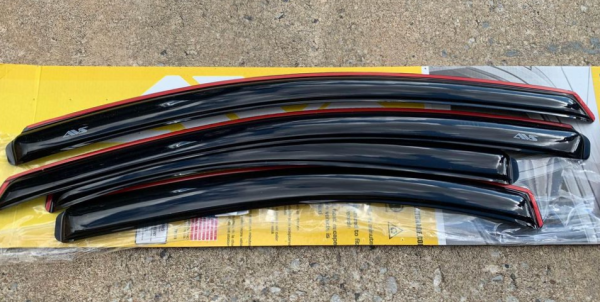Rain guards are great for reducing wind noise and rain spray when you crack your window slightly.

From getting a little breeze while cruising to cracking the windows in your car to keep the inside temperatures down while it is parked, side window deflectors are worth it and open up an entirely new world to you.
Enjoy the fresh air without messing up your hair!
The benefits of side window deflectors are numerous. Here are a few of them:
- Reduces wind noise when windows are open while driving
- Allows windows to be cracked open while raining
- Allows you to leave the windows slightly open when parked
- Adds a sleek, aerodynamic element to your car
- Reduces drag and increases MPG (slightly) when windows are cracked open.
The downside of rain guards is that not everyone likes their visual appearance.
My Favorite wind deflector right now is the Auto Ventshade (AVS). They make them for nearly every brand of car; they are affordable, made in the USA, and have a limited lifetime warranty. Read my reviews on other top brands of wind deflectors.
Growing up without air conditioning, my summers consisted of hot days in the car with the wind beating us mercilessly while we cruised down the highway.
After a long day in town, I was exhausted from the heat and the endless wind.

Hopefully, your air conditioning works, but there are still times when you want to roll down the windows and enjoy the beautiful day.
Wind deflectors let you enjoy that without destroying your hair. You cut down on the ear-popping and the noise while still enjoying the beautiful weather.
You can also crack your windows when it is raining out, reducing window fog while still keeping the inside of your car dry.
Depending on the brand, these go by different names such as wind deflectors and Rain Guards. This article helps you look ar the pros and cons and determine if they are as effective as they claim to be and if they’ll improve your experience.
I had a car with wind deflectors for awhile. When you have them, you use them constantly. There is no worry about thieves seeing your windows opened or with wind noise when parked in a shaded area. I found that I wanted to hang out in my car more often and that they helped my car become a relaxing place of refuge.
Before you buy, you need to understand finishes, coverage area, contouring, and how they connect to your car.
Even if you don’t drive with the windows open, they help to push rain away from the window, giving you clearer visibility.
Rain Guards Are Good For Break-in Prevention
Not only do they hide the fact that your windows are slightly open, but they also make the opening smaller and change the angle a thief would need to try to break into the car with.
Most thieves want an easy target. These help to discourage thieves from your car and make them pick out a different one.
Added Accents

Personally, I like the darkly tinted ones that flow into the existing trim. In my opinion, this makes them hardly noticeable.
However, if you want a window visor that isn’t see-through, you can go with the Chrome finish or camouflaged options. These add some accent to your vehicle while making it even harder to see through them.
If you want more style, these options offer exactly that.
The solid ones increase the size of your “A-pillar” and create a worse blind spot that you will have to workaround.
Do Wind Deflectors Increase Wind Noise?
No wind deflector will completely eliminate wind noise. However, they can reduce it, which makes it easier to chat on the phone when you are driving to work.
At lower speeds, you’ll definitely notice how much noise they cut down on. At highway speeds, you have a less direct impact from the wind, but the noise is still there.
The good news is, they generally don’t add any noise.
Do Window Deflectors Affect MPG?

An open window will alter your car’s aerodynamics from its optimal condition. However, the air conditioner is known to worsen a car’s fuel economy.
The open window vs. air conditioner debate has been raging for a long time.
This Slate Article takes on the debate and references a now-deleted research paper from SAE.org.
In this study, it found that driving with the windows open on a truck or SUV doesn’t affect the miles per gallon much. These vehicles are already so boxy that they have poor aerodynamics.
However, smaller, sleek, sedans begin noticing an MPG reduction at around 68 miles per hour when their windows are opened.
With all vehicles, your MPG seems to improve by turning off the air conditioner and opening the windows at lower speeds. The benefits of rolling up the windows are only there when driving at higher speeds.
With air conditioning, you begin seeing a reduction in MPG immediately, ranging from 3-10% depending on the efficiency of your system and the heat of the day.
Wind deflectors help to soften the wind’s approach so that it flows in an arc and does not get as aggressively sucked inside the car.
This helps to reduce the potential drag from driving with the windows open and could improve MPG.
In-Channel Vs. Stick On
Tape-on window deflectors offer easy installation. They generally use a high-quality adhesive made by a well-recognized company such as 3M.

After you clean the window frame, you simply stick them to the door frame.
Additionally, they can provide better water protection in that they shelter the entire window channel, ensuring that the water flows around the window.
These should be considered permanent fixtures. The adhesive does not remove easily.
Stick-on deflectors are common for rear windows where there isn’t a good channel for inserting them.
Some folks have had problems with these in the car wash, but that seems quite a rare complaint overall.
In-Channel Window visors are another popular option. These are held in place by the tightness of the window channel and do not require adhesive.
Adding a little silicone lubricant to the edge of the deflector before you slip it in helps greatly.
You can pop them in and out should you decide that you don’t like them. They are stuck in pretty well, and I’ve ruined them by trying to remove them.
We have these on our Toyota minivan right now. They rattle a little bit but aren’t noticeable most of the time. Just when we open and close the car door.
They also contact the window, and there is a risk of scratching them.
Size of Window Visors
Most of my readers will want narrower-width deflectors. However, some of my friends drive camping trailers for a living, moving them between sales lots. They are always on the road.
These road warriors love their extra-wide visors. It lets them constantly flow air in any weather, and they can open their windows more before they sneak down past the visor.
These are also a top pick for off-road use, as they help stop the mud and keep the windows cleaner.
Do They Damage Seals?
You want them to rest on the hard part of the rubber seal. Otherwise, it is possible that they can damage the seal.
There is less chance of tape-on deflectors hurting the windows seals.
Do They Hurt Your Car Insurance?
If you buy a brand new car, there is a chance that they can hurt the warranty. You need to make sure that they do not violate any warranty requirements.
There is always a risk of them hurting the paint or the seals. You may want to wait until after the warranty has expired before adding these as an accessory.
Some car insurance plans do not pay for modifications in the event of an accident. You will want to check with your provider and see if they need you to pay for a separate rider in order to insure your window deflectors.
State Laws on Side Deflectors

Side deflectors sometimes fall under windshield obstruction laws. Almost every state has some form of these laws. Here are some of the ones that I see asked about most frequently. Keep in mind that the laws in your area may have changed.
Are They Legal In California?
California is one of the strictest in this regard. With a medical note, a glare shield can be used. Otherwise, anything that obstructs the view of the driver is not allowed.
That said, you see them mounted on cars all over California. It would be wise to stick to the low-profile ones and not pair them with other vehicle modification violations such as windows that are tinted too darkly.
Are They Legal In New York?
In New York, it does not appear that there are strict deflector laws. However, their window tint laws do require at least 70% of the light to be able to pass through.
Are The Legal In Texas?
This is another state where the laws are a little fuzzy. It seems as though solid ones might be illegal, especially if they are large. But it likely that this will only come up during a traffic stop if there is some other suspected infraction.
Are They Legal In New Jersey?
New Jersey has some rules on the books regarding window tint, but I could not find any related to wind deflectors.
Side Window Deflectors Are Worth The Hassle
If you’ve read this far, you are clearly interested in them. Some folks will call them “tacky”, but now we are dealing with matters of taste.
I think they look especially good on GMCs and Dodge Ram trucks.
While you are shopping, also look at one for your sunroof. This makes it much quieter to have the moonroof partially open while at highway speeds.
 Skip to content
Skip to content

